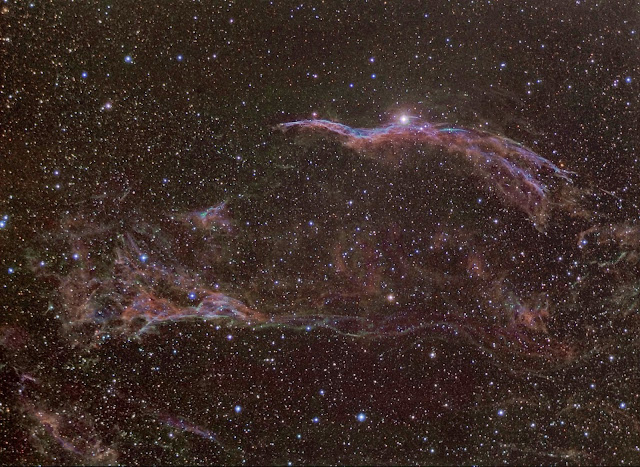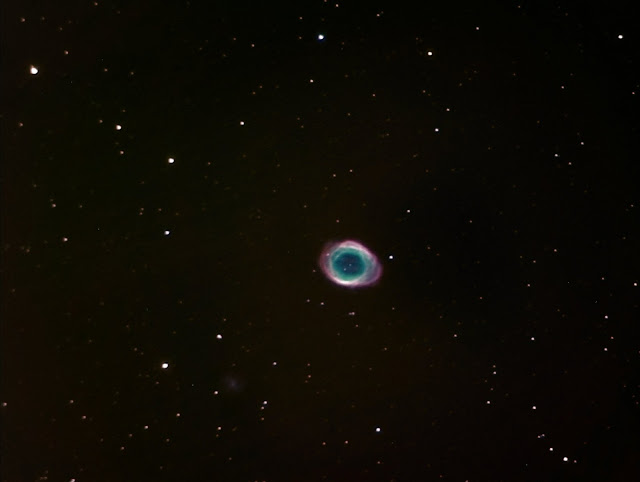The Cygnus loop mosaic. This mosaic is a composition of two images stitched together using Paint Shop Pro.The eastern section (NGC 6992) has been included. Ten minute sub frames were used with matching dark frames, making total exposure times of 60 minutes using an Olll filter, 60 minutes using a H-alpha filter and ten minutes using each colour filter. An 80mm refractor was used with PHD auto guiding, with an Atik 383L mono CCD camera.
The Cygnus Loop
Labelled image
Sunday, 8 December 2013
NGC6960
NGC6960 The Veil Nebula. This Image was taken under clear mooless sky conditions with only light pollution to contend with. A f/7, 80mm refractor was used, with PHD auto guiding and an Atik 383L monochrome CCD camera. Ten minute sub frames were captured with matching dark frames and then stacked them using Deep Sky Stacker. The exposure times were 120 minutes using a H-alpha filter, 80 minutes using an Olll filter. These narrowband exposures were used for the image luminance were as the RGB filters were used for the colour data. The exposure times were 20 minutes for each colour filter making a total exposure time of four hours and twenty minutes.
Narrowband image
Bi-colour image
Combined images
Narrowband image
Bi-colour image
Combined images
Saturday, 23 November 2013
The Soul and Veil Nebulae
NGC 6960 The Veil Nebula.
This image was taken under clear bright moon light conditions. An 80mm refractor was used , PHD auto guiding , and an Atik 383L mono CCD camera . Ten minute sub frames were captured with matching dark frames.The exposure times were 80 minutes using a H-alpha filter, 30 minutes using an O111 filter and ten minutes for each [RGB] colour filter:
IC1848 The Soul Nebula.
This image was taken using a 80mm refractor , PHD auto guiding and an ATIK 383L mono CCD camera.Ten minute sub frames with matching dark frames were captured. The luminance exposure times were sixty minutes using a O111 filter and one hundred and twenty minutes using a H-alpha filter. These data were combined with the colour information captured using RGB filters with exposure times of twenty minutes for each filter:
This image was taken under clear bright moon light conditions. An 80mm refractor was used , PHD auto guiding , and an Atik 383L mono CCD camera . Ten minute sub frames were captured with matching dark frames.The exposure times were 80 minutes using a H-alpha filter, 30 minutes using an O111 filter and ten minutes for each [RGB] colour filter:
IC1848 The Soul Nebula.
This image was taken using a 80mm refractor , PHD auto guiding and an ATIK 383L mono CCD camera.Ten minute sub frames with matching dark frames were captured. The luminance exposure times were sixty minutes using a O111 filter and one hundred and twenty minutes using a H-alpha filter. These data were combined with the colour information captured using RGB filters with exposure times of twenty minutes for each filter:
Monday, 28 October 2013
IC1805 The Heart nebula
IC1805 The Heart nebula. This large exstended object lies in the constellation of Cassiopea the Queen.
This image was taken using an Atik 383L monochrome CCD camera and an 80mm F7 refractor with PHD auto-guiding. The exposure times were sixty minutes using narrowband pass filters (H-alpha and O111). Twenty minute exposures were used for each colour filter RGB filter. Five minute sub frames were used, combined with matching dark frames, making a total exposure time of 180 minutes.
This image was taken using an Atik 383L monochrome CCD camera and an 80mm F7 refractor with PHD auto-guiding. The exposure times were sixty minutes using narrowband pass filters (H-alpha and O111). Twenty minute exposures were used for each colour filter RGB filter. Five minute sub frames were used, combined with matching dark frames, making a total exposure time of 180 minutes.
RGB
Narrowband
Narrowband + RGB
Saturday, 31 August 2013
IC1318 The Butterfly Nebula
IC1318 The Butterfly nebula: This part of the night sky is very rich in nebulosity . It surrounds the bright star Gamma Cygnus at a distance of about 3,000 light years. An Atik 383L mono CCD camera was used with PHD auto guiding and an 80mm f/7 refractor with a field flatterner, making it about f/6.3. Five minute subframes were captured with matching dark frames. The total exposure times were 60 minutes using a H-alpha filter and 15 minutes using RGB filters.
Saturday, 1 June 2013
The Ring and the Dumbbell Nebulae
These images were taken using a Altair ED 2X two inch Barlow lens, a ten inch F 4.8
reflector , PHD autoguiding and an Atik 383L mono CCD camera. The bright planetary
nebula M57, the Ring nebula, shines at about magnitude 8 and lies in the constellation of
Lyra the Harp . Five minute sub frames were captured with matching dark frames, making
total exposure times of twenty minutes for each colour channel . The same equipment and
exposure time were used for M27 , the Dumbbell nebula.
reflector , PHD autoguiding and an Atik 383L mono CCD camera. The bright planetary
nebula M57, the Ring nebula, shines at about magnitude 8 and lies in the constellation of
Lyra the Harp . Five minute sub frames were captured with matching dark frames, making
total exposure times of twenty minutes for each colour channel . The same equipment and
exposure time were used for M27 , the Dumbbell nebula.
Sunday, 12 May 2013
NGC4435 and NGC4438: The Eyes
These galaxies lies deep within the Virgo cluster at a distance of about 52
million light years . This image was taken using a ten inch f/4.8 reflector with
PHD auto guiding .This is a composition of two images taken
using two CCD cameras. An Atik 314L was used for the core luminance and the
surrounding luminance with an Atik 383L mono camera . The exposure times was 60
minutes using 60 second sub frames using the Atik 314L camera and 30 minutes for
each colour filter with five minute sub frames using the Atik 383L camera .
Wednesday, 8 May 2013
M53 and M100
M53. This globular cluster lies at a distance of about 60,000 light years in the
constellation of Coma Berenices. Five minute sub-frames were captured with total
exposure times of 30 minutes for red , green and blue filters . An Atik 383L
mono CCD camera was used with a ten inch f/4.8 reflector and PHD autoguiding:
M100. This spiral galaxy lies in the constellation of Coma
Berenices at a distance of about 50 to 55 million light years . This image was
taken using a ten inch f/4.8 reflector with PHD autoguiding and an Atik 383L
mono CCD. Five minute sub-frames were captured making total exposure times of 30
minutes for each colour filter:
Sunday, 21 April 2013
NGC4567 and NGC4568
NGC4567 and NGC4568 . These to galaxies are situated in the constellation of Virgo and are commonly named the Siamese twins. This pair of galaxies shine at magnitudes 11 and 12 and lies at a distance of about 80 million light years. A ten inch f/4.8 reflector was used with PHD auto guiding and an Atik 383L mono CCD camera. Five minute sub frames and dark frames were captured with total exposure times of 40 minutes for each colour filter ( RGB filters):
Wednesday, 17 April 2013
Comet Panstarrs with the Andromeda galaxy and the Cone Nebula
This image of Comet Panstars 4 was taken from Angle on the Pembrockshire coast using a Canon 50D with a 70 mm lens. The camera was set on ISO 400 with an exposure time of 3 minutes. An Astrotrac mount was used, mounted on a Manfrotto tripod:
NGC2264, the Cone nebula .This faint emission nebula lies at a distance of about 2,700 light years in the constellation of Monoceros . Five minute sub frames and matching dark frames were captured making total exposure times of 90 minutes using a hydrogen alpha filter and ten minutes for each colour filter. A ten inch F4.8 reflector was used, PHD auto guiding software and an Atik 383L mono CCD camera:
Sunday, 17 March 2013
NGC3628
NGC3628. This galaxy lies at a distance of about 35 million light years in the constellation of Leo. Five minute sub frames were captured with matching dark frames, making total exposure times of 60 minutes using a red filter, 30 minutes using a green filter and 20 minutes using a blue filte. An Atik 383 L mono CCD camera was used with a ten inch f/4.8 reflector, using PHD auto guiding.
Sunday, 10 March 2013
The Bubble Nebula
The Bubble nebula. This image is a reprocessed image revealing its surrounding nebuosity. Five minute sub frames and matching dark frames were captured making total exposure times of sixty minutes using a H-alpha filter, sixty minutes using an O111 filter and twenty minutes for each colour filter. Taken using a ten inch F 4.8 reflector, PHD auto-guiding and an Atik 383L mono CCD camera..
Saturday, 9 March 2013
The Rosette nebula
NGC2244 . The Rosette Nebula . This image is a composition taken using an Atik 383L CCD
mono camera, a ten inch F4.8 reflector with PHD auto-guiding. The total exposure time was
ten minutes for each colour filter, 90 minutes using a H-alpha filter and 30 minutes
using an O111 filter. Five minute sub frames were captured with matching dark frames.
Here is a cropped section of the image using false colours revealing the structure.
Wednesday, 13 February 2013
The Horsehead and the Flame nebulae
B33, The Horsehead nebula . This is a section of a vast star forming region in the constellation of Orion . Five minute sub frames and dark frames were captured using an Atik 383L CCD camera, a ten inch f/4.8 reflector and PHD auto guiding software. The total exposure time was 90 minutes using a H-alpha filter and 15 minutes using RGB filters.
NGC2024. This hydrogen emission nebula lies in the star forming complex of Orion the hunter at a distance of about 1,500 light years. Five minute sub frames were captured and combined with matching dark frames. The total exposure time was ninety minutes using a H-alpha filter and twenty minutes using RGB filters. This image was taken using a ten inch f/4.8 reflector, PHD auto guiding and an Atik 383L mono CCD camera.
Mosaic of the two images
NGC2024. This hydrogen emission nebula lies in the star forming complex of Orion the hunter at a distance of about 1,500 light years. Five minute sub frames were captured and combined with matching dark frames. The total exposure time was ninety minutes using a H-alpha filter and twenty minutes using RGB filters. This image was taken using a ten inch f/4.8 reflector, PHD auto guiding and an Atik 383L mono CCD camera.
Mosaic of the two images
Saturday, 12 January 2013
The Flaming Star Nebula
IC405 The Flaming star nebula . This emission and reflection nebula lies at a distance of about 1,500 light years in the constellation of Auriga . This guided image was taken using a ten inch, f/4.8 reflector with an Atik 383L CCD camera . The exposure times were forty minutes for each RGB colour filter and sixty minutes in H-alpha . Five minute sub frames were captured and corrected with matching dark frames .
Nick Hart
Subscribe to:
Comments (Atom)



























